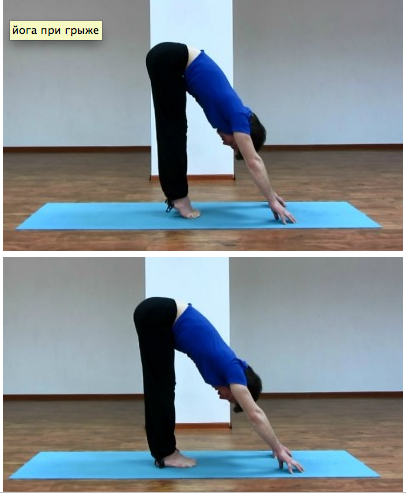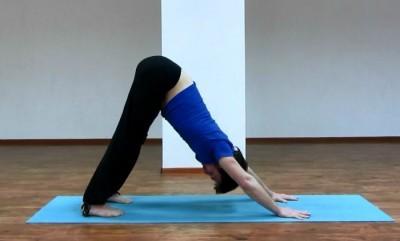Yoga for herniated
 Bashny.Net
Bashny.Net
Intervertebral hernia in our time has become quite a common disease. It is a protrusion of the fibrous ring in the body of a vertebra, beyond the boundaries of anatomical norms, sometimes with complete rupture and displacement of nucleus pulposus from the center the vector of the protrusions with the release of its contents into the cerebrospinal canal.
It occurs not in one moment, and is a natural result of destructive processes in the spine. The decisive factor is most often used improper lifting of a heavy object with a rounded back. Disc herniation is a consequence of degenerative changes in the tissues of the intervertebral discs.

The reason for the development of herniated discs can be the following factors:
1. Inadequate drinking regime.
Due to lack of clean water in the body one of the first begins to suffer connective tissue makes up intervertebral discs. If there is a shortage of water, the discs literally begin to "dry up" and cease to fully perform its cushioning function to the spine. Axial load begins to be distributed on the vertebral body, which accelerates the formation of a hernia.
2. Incorrect load distribution with the incorrect position of the spine.
Due to the fact that people are ignoring the physiological position of the spine, begins to slouch or bend your back when lifting weights, the available resource strength of the vertebra is significantly reduced.
3. The lack of adequate physical activity.
Due to sedentary lifestyle and detrenirovannosti musculoskeletal occurs nutrition of the tissues which comprise the intervertebral disc. The spine is constantly in non-physiological condition, causing growing over time, the degree of discomfort.
4. Unbalanced nutrition.
The structure of the tissues of the spine are constantly being updated due to the nutrients entering the body with food. Most important for bone health are phosphorus, calcium, potassium and magnesium. When there is a lack of bone tissue becomes porous, and the intervertebral discs no longer cope with its function.
Diagnosis of a herniated disc is performed by means of x-ray, MRI and CT.
Symptoms of a herniated disc depend directly on its location.
Most often the "weak area" is the lumbar spine, rarely in the cervical and thoracic.
The lumbar spine:
— numbness in the toes
— localized pain in the foot or lower leg
— numbness in the groin area
— prolonged pain (3 months or more) in the lumbar region
— leg pain that is spread most often at the side and rear, at least – at the front of the thigh
Treatment of a herniated disc based on either operational (elimination of defects using surgery) or a conservative approach (physical, chiropractic and physiotherapy techniques).
Yoga for herniated can render great assistance in healing from this disease, if is based on the basic yogic principle of Ahimsa and is supported by a change of diet.
When you perform yogic exercises (asanas) people with herniated discs should be guided by the following principles:
1. If you are performing exercises does not arise pain in the problem area, it is suitable for You and you can use it. If there is slight pain, then this exercise can also be performed, but with great attention and caution. If when you perform the asanas You feel a sharp pain, it is at this point in time to execute is not worth it.
2. Avoid hard blows, jolts in the back, jumps
3. At the initial stage to avoid exercise for a spinal twist
4. It is desirable to perform a set of exercises several times throughout the day (at least three times)
5. Do not exert sudden aggressive efforts to problem areas – do each exercise smoothly and deliberately
6. Start the asana with minimal loads, gradually over time, increasing their
7. Do not put a goal to cure the spine in a single day – regular and persistent repetition over time will bring the desired therapeutic effect.
I offer a set of simple asanas that regular performance in combination with a well-balanced diet will help to get rid of annoying problems when unexpressed hernia, localized in the lumbar or thoracic.

Orthotamine


Downward dog

Chaturanga Dandasana

Urdhva Mukha of svanasana (face up)

Be extremely careful when performing this asana if You have problems with the lumbar spine. Do not create excess tension and compression in this region.
Strive at first to pull the spine out of the pelvis, and only then carry out light deflection.
If you are performing the asanas present pain or pronounced discomfort — get her from his practice.

If You have the opportunity to "portageville" in old simulator "RULE" (accent 2nd syllable), courses acupuncture, physiotherapy, massage, it will also greatly assist in the healing process. published
P. S. And remember, only by changing their consumption — together we change the world! © Join us at Facebook , Vkontakte, Odnoklassniki
Source: slavyoga.ru/yoga-pri-mezhpozvonochnoy-gryizhe.html
It occurs not in one moment, and is a natural result of destructive processes in the spine. The decisive factor is most often used improper lifting of a heavy object with a rounded back. Disc herniation is a consequence of degenerative changes in the tissues of the intervertebral discs.

The reason for the development of herniated discs can be the following factors:
1. Inadequate drinking regime.
Due to lack of clean water in the body one of the first begins to suffer connective tissue makes up intervertebral discs. If there is a shortage of water, the discs literally begin to "dry up" and cease to fully perform its cushioning function to the spine. Axial load begins to be distributed on the vertebral body, which accelerates the formation of a hernia.
2. Incorrect load distribution with the incorrect position of the spine.
Due to the fact that people are ignoring the physiological position of the spine, begins to slouch or bend your back when lifting weights, the available resource strength of the vertebra is significantly reduced.
3. The lack of adequate physical activity.
Due to sedentary lifestyle and detrenirovannosti musculoskeletal occurs nutrition of the tissues which comprise the intervertebral disc. The spine is constantly in non-physiological condition, causing growing over time, the degree of discomfort.
4. Unbalanced nutrition.
The structure of the tissues of the spine are constantly being updated due to the nutrients entering the body with food. Most important for bone health are phosphorus, calcium, potassium and magnesium. When there is a lack of bone tissue becomes porous, and the intervertebral discs no longer cope with its function.
Diagnosis of a herniated disc is performed by means of x-ray, MRI and CT.
Symptoms of a herniated disc depend directly on its location.
Most often the "weak area" is the lumbar spine, rarely in the cervical and thoracic.
The lumbar spine:
— numbness in the toes
— localized pain in the foot or lower leg
— numbness in the groin area
— prolonged pain (3 months or more) in the lumbar region
— leg pain that is spread most often at the side and rear, at least – at the front of the thigh
Treatment of a herniated disc based on either operational (elimination of defects using surgery) or a conservative approach (physical, chiropractic and physiotherapy techniques).
Yoga for herniated can render great assistance in healing from this disease, if is based on the basic yogic principle of Ahimsa and is supported by a change of diet.
When you perform yogic exercises (asanas) people with herniated discs should be guided by the following principles:
1. If you are performing exercises does not arise pain in the problem area, it is suitable for You and you can use it. If there is slight pain, then this exercise can also be performed, but with great attention and caution. If when you perform the asanas You feel a sharp pain, it is at this point in time to execute is not worth it.
2. Avoid hard blows, jolts in the back, jumps
3. At the initial stage to avoid exercise for a spinal twist
4. It is desirable to perform a set of exercises several times throughout the day (at least three times)
5. Do not exert sudden aggressive efforts to problem areas – do each exercise smoothly and deliberately
6. Start the asana with minimal loads, gradually over time, increasing their
7. Do not put a goal to cure the spine in a single day – regular and persistent repetition over time will bring the desired therapeutic effect.
I offer a set of simple asanas that regular performance in combination with a well-balanced diet will help to get rid of annoying problems when unexpressed hernia, localized in the lumbar or thoracic.

Orthotamine


Downward dog

Chaturanga Dandasana

Urdhva Mukha of svanasana (face up)

Be extremely careful when performing this asana if You have problems with the lumbar spine. Do not create excess tension and compression in this region.
Strive at first to pull the spine out of the pelvis, and only then carry out light deflection.
If you are performing the asanas present pain or pronounced discomfort — get her from his practice.

If You have the opportunity to "portageville" in old simulator "RULE" (accent 2nd syllable), courses acupuncture, physiotherapy, massage, it will also greatly assist in the healing process. published
P. S. And remember, only by changing their consumption — together we change the world! © Join us at Facebook , Vkontakte, Odnoklassniki
Source: slavyoga.ru/yoga-pri-mezhpozvonochnoy-gryizhe.html
Tags
See also
Find out what visceral fat is and how dangerous it is
BAPV AND BIPV solar panels: what's the difference?
How to get rid of gastritis for 2 weeks !
How to remove marks from acne
Enzymes in the human body: IT is NECESSARY to know everyone!
Exercises for the treatment of osteoarthritis of the fingers
Normal back pain or disc herniation?

















